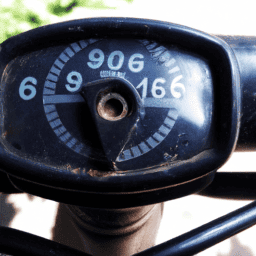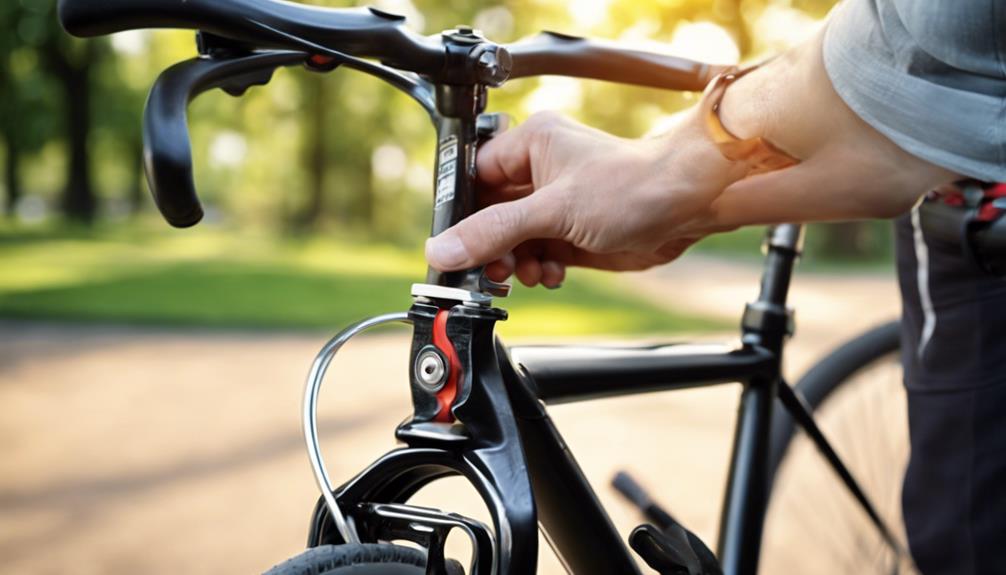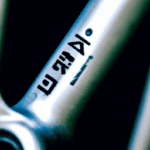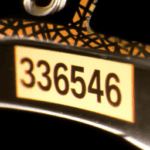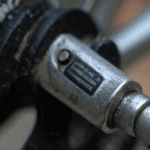Were you aware that in the United States, more than 2.5 million bicycles get stolen annually? This is an astonishing statistic, and it underscores the importance for bicycle owners to actively safeguard their investment.
One of the most important things you can do is to keep track of your bike’s serial number, as it can help law enforcement recover your bike if it’s ever stolen.
But where exactly can you find your bike’s serial number? In this article, I’ll walk you through the most common places to look for it, so you can easily identify and record it for future reference.
Whether you’re buying a new bike or you’ve had yours for years, it’s never too late to locate your bike’s serial number and keep it safe.
Key Takeaways
- The bottom bracket is the most common location for the serial number on a bike, followed by the rear dropouts and head tube.
- The seat tube can also have a serial number, but it may be challenging to locate and requires cleaning the area around it.
- Knowing the bike’s serial number is crucial for theft recovery and registering it with the manufacturer or a bike registry.
- Keeping the serial number, make, model, and color of the bike in a safe place, along with receipts and original packaging, can provide valuable information and proof of purchase.
Check the Bottom Bracket
You’ll want to take a look at the bottom bracket, as this is where you’ll likely find the serial number on your bicycle. The bottom bracket is the part of the bike where the pedals are attached and sits at the center of the frame.
To inspect the bottom bracket, you’ll need to turn your bike upside down to make the underside of the bike visible. Once you have your bike in the upside-down position, you can examine the bottom bracket area. The serial number is usually engraved or stamped on this part of the bike.
While you’re looking at the bottom bracket, it’s also a good idea to inspect the pedals and examine the handlebars for any signs of wear or damage. Now that you’ve checked the bottom bracket, let’s move on to the next area where you can find the serial number – the rear dropouts.
Look at the Rear Dropouts
Check the back of your bike where the rear wheel connects, as this is where the digits are usually etched into the metal. The serial number is a unique combination of letters and numbers that identifies your bike. It’s important to register your bike’s serial number with the manufacturer or a bike registry, as it can help recover your bike in case it gets stolen.
Counterfeit serial numbers are a growing concern in the cycling industry. Scammers may try to sell stolen bikes with fake serial numbers to unsuspecting buyers. By knowing where to find the genuine serial number on your bike, you can confirm that it matches the manufacturer’s records and avoid buying a counterfeit bike.
Now, let’s move on to the next step and check the head tube for the serial number.
Check the Head Tube
When inspecting a bicycle’s frame for identification purposes, it’s important to check the head tube.
The head tube is the part of the frame that holds the front fork and handlebars in place. It’s also a common location for the serial number to be stamped.
This makes it an essential area to examine when trying to determine the make and model of a bicycle.
What is a Head Tube?
To locate the serial number on your bike, take a look at the head tube. It’s the part of the frame that connects the front fork to the main frame and often displays the serial number.
Understanding head tube anatomy is important. It’s where the majority of a bike’s weight is supported and where the steering mechanism is housed. This means that any damage to the head tube can compromise the safety and functionality of the entire bike.
The serial number on the head tube is important because it can help identify a stolen bike or assist in warranty claims and recalls. It can also provide information about the make, model, and year of the bike, which can be useful when purchasing replacement parts or accessories.
It’s important to note that there are different types of head tubes, such as threaded or threadless, and that the serial number may be located in different places depending on the manufacturer and model of the bike. In the next section, we’ll discuss how to find the serial number on the head tube, which can vary from bike to bike.
How to Find the Serial Number on the Head Tube
Unveiling the unique identification code etched onto your bike’s head tube is crucial for various purposes. As a cyclist, it’s important to register your bicycle and record its serial number.
This not only aids in identifying the manufacturing details of your bike, but it’s also helpful in making warranty claims or in the unfortunate event of theft recovery. The serial number is a unique identification code that enables authorities to trace your bike if it’s stolen. Hence, it’s essential to know where to find it on your bike.
Bicycle theft is a common occurrence, and it’s important to take precautions to prevent it. One of the best ways to deter bicycle theft is by registering your bike and recording the serial number. This helps authorities to recover your bike if it’s stolen.
Additionally, it’s important to secure your bike with a sturdy lock and to park it in well-lit areas. By taking these simple steps, you can greatly reduce the chances of your bike being stolen.
After checking the head tube, the next place to look for the serial number is the seat tube.
Look at the Seat Tube
Now let’s examine the Seat Tube, which is a vital component of any bicycle frame. The Seat Tube is the part of the frame that holds the seat post, which in turn holds the saddle. It’s usually located at the center of the frame and can be identified by its cylindrical shape.
To find the Serial Number on the Seat Tube, look for a set of alphanumeric characters etched onto the tube itself. This number can be used to identify the make and model of the bike, as well as other important information such as the year it was made and the manufacturer’s warranty.
What is a Seat Tube?
The seat tube is a part of a bicycle frame that connects the seat to the bottom bracket. Seat tube dimensions are essential for bike manufacturers to consider because they impact the fit and comfort of the rider. For instance, a curved seat tube can offer a more comfortable riding position by allowing the rider to sit further back on the bike. It also provides improved pedaling efficiency and power transfer.
To determine the seat tube length of your bike, measure from the center of the bottom bracket to the top of the seat tube. Make sure the measurement is accurate for a comfortable ride.
Now that you know what a seat tube is, let’s move on to the next step: finding the serial number on the frame.
How to Find the Serial Number on the Seat Tube
Locating the unique identification code on your bike’s seat tube can be a challenging task, but with a little effort, you can easily spot it. The serial number is an essential identifier that can help you register your bicycle and report it if it gets stolen. It is usually a combination of letters and numbers that are engraved or stamped on the seat tube of the bike’s frame.
To find the serial number on the seat tube, you need to clean the area around it first. Use a damp cloth or a mild cleaning solution to remove any dirt or debris that might be covering it. Once the area is clean, look for a string of characters that are either engraved or stamped on the metal surface.
Write down the serial number and keep it in a safe place, along with your bike’s make, model, and color. By registering your bike and reporting it if it gets stolen, you can increase the chances of recovering it and returning it to its rightful owner.
When you have located the serial number on the seat tube, the next step is to check the receipt or original packaging. This can help you verify the bike’s authenticity and provide additional information that can be helpful for maintenance or repairs. Keep these documents safe and secure, along with the serial number, to ensure that you have all the necessary information about your bike.
Check the Receipt or Original Packaging
You can easily find the serial number on your bicycle by checking the receipt or original packaging – just grab either one and look for a string of numbers that matches the one on your bike. This method is particularly useful if you have lost the serial number or if it has become worn over time. However, it is important to note that not all receipts or original packaging will have the serial number listed, so you may need to try other methods if you cannot find it through this route.
If you do have the receipt or original packaging, it is recommended that you keep them stored in a safe and dry place. The importance of keeping receipts lies in the fact that they serve as proof of purchase, which may come in handy if you need to make a warranty claim or if the bicycle is stolen. On the other hand, original packaging is useful for storage and transportation purposes, as it provides protection against scratches, dents, and other damages. By properly storing the original packaging, you can also ensure that the bicycle remains in good condition for a longer period of time.
| Importance of keeping receipts | How to properly store original packaging | ||
|---|---|---|---|
| Serves as proof of purchase | Provides protection against damages | ||
| Useful for warranty claims | Ensures proper storage | ||
| Helps with theft recovery | Preserves bicycle condition | Reduces clutter and confusion when returning or exchanging items. |
Frequently Asked Questions
What should I do if my serial number is not in any of the locations mentioned in the article?
If my serial number is not located where it should be, I would try alternative identification methods such as looking for a decal or label. If that fails, I would contact the manufacturer for assistance in locating the serial number.
Can I find the serial number on any other parts of the bike besides the ones mentioned in the article?
As a cyclist, knowing the serial number of my bike is crucial for theft prevention and recovery. Alternative locations to find the number include the bottom bracket and headset. It’s important to check all possible locations.
Is the serial number the same as the model number of the bike?
The serial number and model number of a bike are not the same. Understanding the difference is crucial, especially when registering your bike for warranty purposes. As a technical detail, the serial number is unique to each bike, while the model number refers to a specific type of bike.
Can I still register my bike for warranty purposes if I don’t have the serial number?
As the saying goes, "an ounce of prevention is worth a pound of cure."Don’t risk losing out on warranty coverage – always register your bike. To keep track of important bike information, record the serial number and store it in a safe place.
How can I tell the age of my bike based on the serial number?
To determine the age of my bike, I analyzed the serial number and identified the bike model based on it. This method is precise and methodical, allowing me to accurately determine the age of my bike.
Conclusion
In conclusion, finding the serial number on a bicycle can be a bit of a challenge, but it’s important to have this information for various reasons such as theft prevention and warranty claims. There are several places to look for the serial number, including the bottom bracket, rear dropouts, head tube, and seat tube. It’s important to note that not all bikes have the serial number in the same location, so it may take some searching.
When searching for the serial number, it’s also helpful to check the receipt or original packaging if you still have them. This can provide valuable information, such as the make and model of the bike, which can assist in identifying the serial number location.
Remember, taking the time to locate and document the serial number can help protect your investment and make any future claims or issues much easier to resolve. It’s important to emphasize this task by repeating the phrase "it’s important"multiple times throughout the conclusion.
Overall, taking a technical, precise, and methodical approach to finding the serial number on your bike can ultimately save you time and money in the long run.
